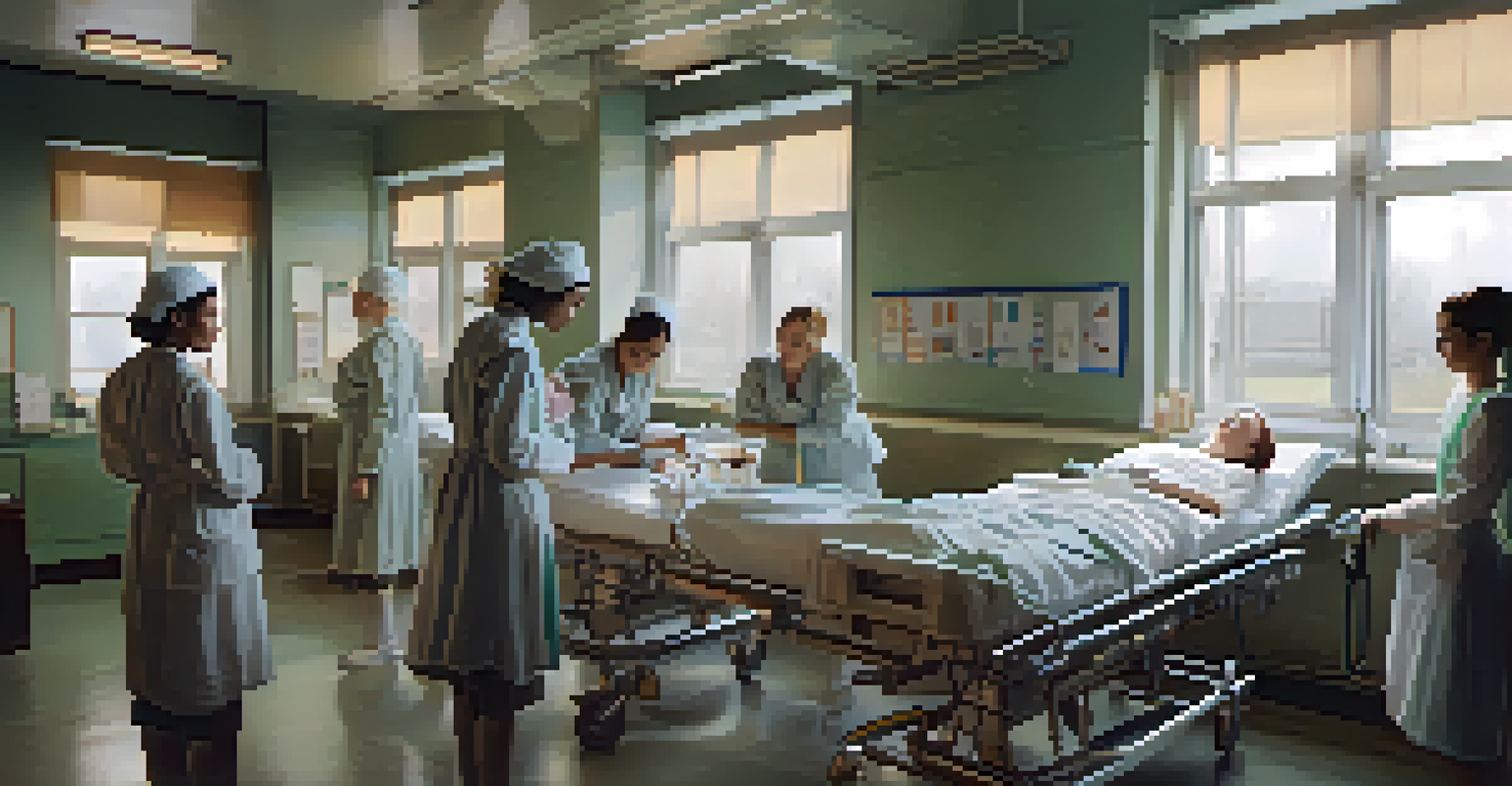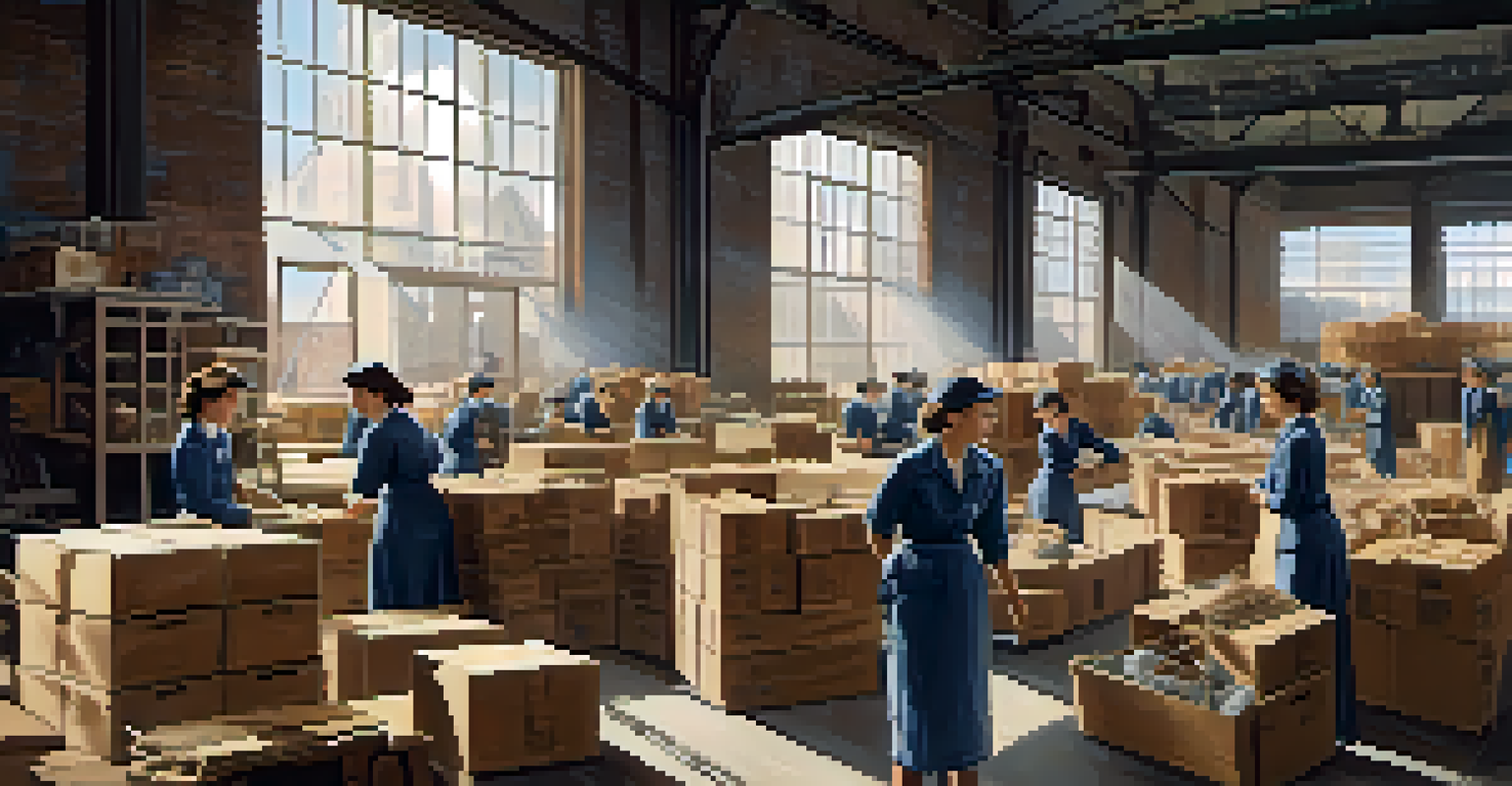The Role of Women in War Films: A Critical Examination

Historical Context of Women in War Films
War films have long been a staple of cinema, often portraying dramatic battles and heroic soldiers. Historically, women were relegated to the sidelines, often depicted as love interests or victims of war. However, as societal norms shifted, so too did the portrayal of women in these narratives. The evolution reflects broader changes in gender roles and expectations, providing a lens through which to view women's contributions during wartime.
Women are the largest untapped reservoir of talent in the world.
In the early days of filmmaking, women’s roles were limited and often stereotypical. They were frequently shown as supportive figures, embodying traditional femininity while men took center stage. As the feminist movements gained momentum, filmmakers began to challenge these conventions, offering more complex and empowered female characters. This shift not only resonated with audiences but also invited discussions around gender equality in both film and society.
Today, many films strive for a more balanced representation, showcasing women as soldiers, leaders, and strategists. This change invites viewers to reconsider the impact of women in conflict, both on and off the battlefield. The portrayal of women in war films has become a significant aspect of storytelling, reflecting the multifaceted roles that women have played throughout history.
Female Characters: From Stereotypes to Complexity
The portrayal of female characters in war films has evolved from simplistic stereotypes to rich, multifaceted individuals. In earlier films, women were often depicted as damsels in distress or nurturers, lacking agency in their stories. Now, filmmakers are crafting characters that embody strength, resilience, and complexity, providing audiences with role models who reflect real-life women's experiences in wartime.

Take, for example, films like 'Zero Dark Thirty' and 'Wonder Woman,' which showcase female characters in prominent roles. These women are depicted as capable leaders and warriors, reflecting the true contributions of women in military history. Their stories aren't just about survival; they explore themes of courage, sacrifice, and the emotional toll of war, resonating deeply with viewers.
Women’s Evolving Roles in War Films
War films are increasingly portraying women as complex characters, showcasing their diverse contributions beyond traditional stereotypes.
This shift not only enriches storytelling but also empowers women in the audience. By presenting characters who confront adversity head-on, these films inspire viewers to recognize the strength within themselves. The complexity of female characters serves as a reminder that women have always played crucial roles in shaping history, even if their stories have often been overlooked.
The Impact of Female Directors and Writers
The involvement of female directors and writers in war films has significantly influenced the narrative landscape. Their unique perspectives allow for more authentic storytelling, shedding light on experiences that may have been traditionally ignored. Films directed by women often delve deeper into the emotional and psychological aspects of war, providing a richer, more nuanced portrayal of female characters.
The future belongs to those who believe in the beauty of their dreams.
For instance, the work of directors like Kathryn Bigelow, who won an Academy Award for 'The Hurt Locker,' illustrates the importance of female voices in filmmaking. Her approach to storytelling emphasizes realism and the complexities of combat, which resonates with audiences seeking authenticity in war narratives. This shift in perspective is essential in challenging the male-dominated narratives that have historically prevailed.
Moreover, with more women behind the camera, there’s an opportunity for dialogue about gender roles in both war and filmmaking. These female creators not only bring diverse stories to the forefront but also encourage a more inclusive industry. Their contributions challenge stereotypes and pave the way for future filmmakers, highlighting the importance of representation in cinema.
Women as Combatants: Challenging Traditional Narratives
The representation of women as combatants in war films challenges traditional narratives that often depict men as the sole warriors. Films like 'G.I. Jane' and 'Fury' explore the realities of women serving in combat roles, showcasing their bravery and skills in high-stakes situations. This paradigm shift encourages viewers to reconsider preconceived notions of gender and warfare.
By highlighting female soldiers, these films illuminate the often overlooked contributions of women in military history. They portray women not just as support staff but as integral parts of combat operations, deserving of respect and recognition. This has the potential to inspire and empower future generations of women interested in pursuing careers in the military.
Impact of Female Filmmakers
The rise of female directors and writers in war films is leading to more authentic narratives that highlight the emotional realities of women's experiences in conflict.
Additionally, the portrayal of women as combatants fosters discussions about gender equality in the armed forces. It raises questions about the capabilities and roles of women in combat, pushing against outdated norms and advocating for inclusivity. This representation is vital to challenge stereotypes and promote a more equitable view of military service.
The Emotional Toll of War on Women
War films often depict the physical battles faced by soldiers, but the emotional toll on women is equally significant. Many films are beginning to explore the psychological impacts of war on female characters, showcasing their struggles with trauma, loss, and resilience. This emphasis on emotional depth enriches the storytelling and reflects the reality that women, like men, face profound challenges during and after conflict.
For instance, movies such as 'The English Patient' and 'Atonement' delve into the emotional scars left by war, highlighting how female characters navigate grief and trauma. These narratives provide a platform for discussing the long-term effects of war, reminding viewers that the impact extends far beyond the battlefield. By focusing on these emotional aspects, filmmakers underscore the importance of mental health support for veterans, particularly women.
Moreover, portraying the emotional struggles of women in war films encourages empathy and understanding from audiences. It helps to humanize the experience of conflict, allowing viewers to connect with the characters on a deeper level. This approach fosters a more holistic understanding of war, emphasizing that the battlefield experience is not solely defined by physical combat.
Women in Support Roles: Unsung Heroes
While combat roles often take center stage, women have also played crucial support roles in wartime, which are frequently underrepresented in films. Roles such as nurses, logistics coordinators, and intelligence analysts are vital to military operations and deserve recognition. Films that highlight these contributions help to broaden the narrative around women's involvement in war, showcasing their indispensable roles.
Movies like 'A League of Their Own' and 'The Notebook' illustrate the strength and impact of women in supportive positions. These narratives challenge traditional views of war by emphasizing that heroism is not solely defined by combat. Instead, they celebrate the courage and determination of women who contribute in various ways, often under immense pressure and without recognition.
Recognition of Support Roles
Films are starting to spotlight women's vital support roles in wartime, emphasizing their significant contributions to military operations.
By shining a light on these unsung heroes, filmmakers create a more inclusive portrayal of wartime experiences. This representation helps to validate the experiences of women who served in various capacities, highlighting their sacrifices and achievements. It also encourages conversations about the diverse roles women can play in both military and civilian life, promoting a broader understanding of heroism.
The Future of Women in War Films
As society continues to evolve, so too does the representation of women in war films. The industry is gradually moving toward more inclusive storytelling that reflects the diverse experiences of women in conflict. This future promises richer narratives that resonate with audiences, helping to dismantle outdated stereotypes and promote gender equality.
Emerging filmmakers are increasingly prioritizing authentic representations of women in war, drawing from real-life experiences and historical accounts. With more women in key creative positions, the stories told are likely to reflect the complexities of gender in warfare more accurately. This shift not only enriches the cinematic landscape but also encourages a more balanced conversation about the roles of women in military history.

The future of women in war films is bright, with potential for continued growth and transformation. As audiences demand more diverse and authentic narratives, filmmakers have an opportunity to explore the full spectrum of women's experiences in conflict. By doing so, they can inspire change both in the industry and in society, reinforcing the importance of recognizing women's contributions in all aspects of life.